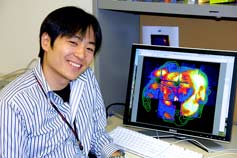
Handy Links
SLAC News Center
SLAC Today
- Subscribe
- Archives: Feb 2006-May 20, 2011
- Archives: May 23, 2011 and later
- Submit Feedback or Story Ideas
- About SLAC Today
SLAC News
Lab News
- Interactions
- Lightsources.org
- ILC NewsLine
- Int'l Science Grid This Week
- Fermilab Today
- Berkeley Lab News
- @brookhaven TODAY
- DOE Pulse
- CERN Courier
- DESY inForm
- US / LHC
SLAC Links
- Emergency
- Safety
- Policy Repository
- Site Entry Form

- Site Maps
- M & O Review
- Computing Status & Calendar
- SLAC Colloquium
- SLACspeak
- SLACspace
- SLAC Logo
- Café Menu
- Flea Market
- Web E-mail
- Marguerite Shuttle
- Discount Commuter Passes
-
Award Reporting Form
- SPIRES
- SciDoc
- Activity Groups
- Library
Stanford
Around the Bay
Shedding Light on a Cosmic Mystery
 A SLAC astrophysicist and his collaborators may have finally solved the long-standing conundrum about the origin of cosmic rays. These streams of subatomic particles—mostly protons—continuously careen through our galaxy, bombarding Earth's atmosphere with tremendous energies. Since their discovery in 1912, researchers have marveled at how ordinary particles could attain such extraordinary energies, but despite intense experimental and theoretical efforts, these questions have eluded definitive answers.
A SLAC astrophysicist and his collaborators may have finally solved the long-standing conundrum about the origin of cosmic rays. These streams of subatomic particles—mostly protons—continuously careen through our galaxy, bombarding Earth's atmosphere with tremendous energies. Since their discovery in 1912, researchers have marveled at how ordinary particles could attain such extraordinary energies, but despite intense experimental and theoretical efforts, these questions have eluded definitive answers.
The predominant theory has posited that cosmic rays are accelerated in the supersonic shocks surrounding supernova remnants. According to this hypothesis, turbulent magnetic fields force the particles to ricochet wildly across the shockfront, gaining energy with every crossing until eventually releasing into the cosmos at relativistic speeds. Until now, however, most evidence for this conjecture was circumstantial, relying on theory and logic rather than direct observation.
Kavli Institute for Particle Astrophysics and Cosmology (KIPAC) post-doc Takaaki Tanaka and colleagues have found definitive evidence that supernova remnants are accelerators of cosmic rays, reporting their results in the October 4 issue of Nature. The research team, which included colleagues from the Institute of Space and Astronautical Science at the Japan Aerospace Exploration Agency (ISAS/JAXA), Dublin Institute for Advanced Studies, and the Max-Planck Institute in Heidelberg, conducted observations with the Chandra and Suzaku x-ray telescopes of the supernova remnant RX J1713.7-3946.
The detected x-rays are presumed to be synchrotron radiation, emitted when electrons interact with magnetic fields. In a magnetic field typical of the interstellar medium—approximately 5 microgauss—particles producing synchrotron radiation require hundreds of years to accelerate and cool. In the vicinity of RX J1713, however, Tanaka and colleagues made a surprising discovery: the x-ray emission was variable over a timescale of a single year. "The particles responsible for the x-rays must be gaining and losing their energies very rapidly," Tanaka said. "This kind of flux can only be explained by a strongly amplified magnetic field."
The authors calculated the strength of the magnetic field to be at least 1 milligauss, nearly three orders of magnitude larger than that of the interstellar medium. The milligauss-scale is a key condition for accelerating protons and nuclei to cosmic-ray energies of PeV (1015 eV) and beyond.
These results complement data from an earlier study, which identified RX J1713 as a source of very-high-energy, tera-electron-volt-range gamma-rays, thus hinting at cosmic ray acceleration. Until the present study, however, it was difficult to conclude whether these gamma-rays were emitted by electrons or protons. According KIPAC physicist Greg Madejski, "we now have strong evidence that the gamma-ray emission is via collisions of energetic protons rather than electrons. RX J1713 will be a great target for GLAST!"
Roger Blandford, director of KIPAC, agrees. "The origin of cosmic rays is a puzzle that's nearly a century old. It's great to finally get some clarity on the issue."
—Elizabeth Buchen, SLAC Today, October 4, 2007
Above image: SLAC's Takaaki Tanaka has found direct evidence that supernova remnant RX J1713.7-3946 (here imaged with Suzaku X-ray telescope) can accelerate cosmic rays up to 1015 eV. (Click image for larger version.)